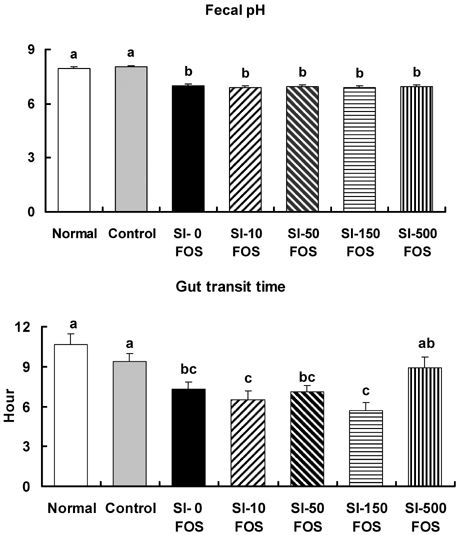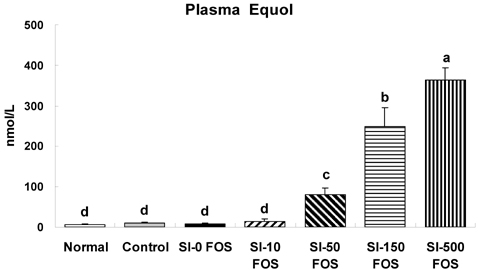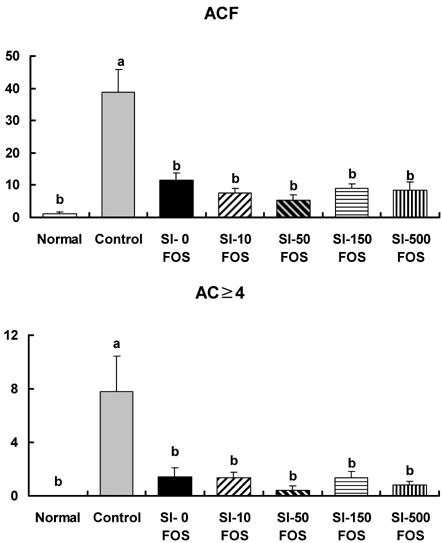Nutr Res Pract.
2008 Jun;2(2):55-61.
Dose-response assessment of the anti-cancer efficacy of soy isoflavones in dimethylhydrazine-treated rats fed 6% fructooligosaccharide
- Affiliations
-
- 1Department of Food and Nutrition, Daegu University, Gyeongbuk 712-714, Korea. yschoi@daegu.ac.kr
Abstract
- We investigated the combinatorial effects of different doses of dietary soy isoflavones (SI) and fructooligosaccharide (FOS) in a rat model of colon cancer. We hypothesized that increased bioavailability of SI metabolites due to dietary FOS may increase production of bioactive equol and affect colon carcinogenesis in a dose-dependent manner. Sprague-Dawley male rats were injected with 12-dimethylhydrazine (DMH) and were provided experimental diets that contained 0, 10, 50, 150, or 500 mg SI per kg of diet and 6% FOS for 12 weeks. The number of aberrant crypt foci (ACF) and the expression of cyclooxygenase-2 (COX-2) in colonic tissues were significantly decreased in the 6% FOS-fed groups compared to the control group. Gut transit time and fecal pH were significantly lower, and fecal concentrations of bifidobacteria were increased with 6% FOS. However, dietary SI supplementation in combination with 6% dietary FOS did not affect ACF formation or COX-2 expression. Plasma equol concentrations were dose-dependently increased by supplementation of SI up to 500 mg/kg of diet. In conclusion, SI supplementation up to 500 mg/kg of diet appeared to have no additive beneficial effects in rats with chemically-induced colon cancer that were fed 6% FOS, although plasma equol was dose-dependently increased.
MeSH Terms
Figure
Reference
-
1. Adlercreutz H. Phytoestrogens: epidemiology and a possible role in cancer protection. Environ Health Perspect. 1995. 103:103–112.
Article2. American Institute of Nutrition. Report of the ad hoc committee on standards for nutrition studies. J Nutr. 1993. 123:1939–1951.3. Atkinson C, Berman S, Humbert O, Lampe JW. In vitro incubation of human feces with daidzein and antibiotics suggests interindividual differences in the bacteria responsible for equol production. J Nutr. 2004. 134:596–599.
Article4. Atkinson C, Frankenfeld CL, Lampe JW. Gut bacterial metabolism of soy isoflavone daidzein: Exploring the relevance to human health. Exp Biol Med (Maywood). 2005. 230:155–170.
Article5. Bird RP. Role of aberrant crypt foci in understanding the pathogenesis of colon cancer. Cancer Lett. 1995. 93:55–71.
Article6. Bird RP, Good CK. The significance of aberrant crypt foci in understanding the pathogenesis of colon cancer. Toxicol Lett. 2000. 112-113:395–402.
Article7. Birt DF, Hendrich S, Wang W. Dietary agents in cancer prevention: flavonoids and isoflavonoids. Pharmacol Ther. 2001. 90:157–177.
Article8. Brouwers E, L'homme R, Al-Maharik N, Lapck O, Hampl R, Wahala K, Mikola H, Adlercreutz H. Time-resolved fluoroimmunoassay for equol in plasma and urine. J Steroid Biochem Mol Biol. 2003. 84:577–587.
Article9. Cho JW, Park K, Kweon GR, Jang BC, Baek WK, Suh MH, Kim CW, Lee KS, Suh SI. Curcumin inhibits the expression of COX-2 in UVB-irradiated human keratinocytes (HaCaT) by inhibiting activation of AP-1: p38 MAP kinase and JNK as potential upstream targets. Exp Mol Med. 2005. 37:186–192.
Article10. Cotterchio M, Boucher BA, Manno M, Gallinger S, Okey A, Harper P. Dietary phytoestrogen intake is associated with reduced colorectal cancer risk. J Nutr. 2006. 136:3046–3053.
Article11. Cummings JH, Bingham SA. Diet and the prevention of cancer. BMJ. 1998. 317:1636–1640.
Article12. Daly KT, Tracy AC, Malik M, Wang T, Francke-Carroll S, Magnuson BA. Enhanced estrogenic responses and sensitivity to azoxymethane following dietary soy isoflavone supplementation in older female rats. Food Chem Toxicol. 2007. 45:628–637.
Article13. Guo JY, Li X, Browning J, Rottinghaus GE, Lubahn DB, Constantinou A, Bennink M, MacDonald R. Dietary soy isoflavones and estrone protect ovariectomized ERαKO and wild-type mice from carcinogen-induced colon cancer. J Nutr. 2004. 134:179–182.
Article14. Jacoby RF, Seibert K, Cole CE, Kelloff G, Lubet RA. The cyclooxygenase-2 inhibitor celecoxib is a potent preventive and therapeutic agent in the min mouse model of adenomatous polyposis. Cancer Res. 2000. 60:5040–5044.15. Ji GE, Kim IH, Lee SK. Investigation of selective medium for isolation and enumeration of Bacteriodes sp. from the feces of the Korean people. Korean Journal of Food Science and Technology. 1994. 26:295–299.16. Khalil DA, Lucas EA, Smith BJ, Soung DY, Devareddy L, Juma S, Akhter MP, Recker AR, Arjmandi BH. Soy isoflavones may protect against archidectomy-induced bone loss in aged male rats. Calcif Tissue Int. 2005. 76:50–62.17. Lim CC, Ferguson LR, Tannock GW. Dietary fibers as "prebiotics" : implications for colorectal cancer. Mol Nutr Food Res. 2005. 49:609–619.18. McClain RM, Wolzm E, Davidovish A, Pfannkuch F, Edwards JA, Bausch J. Acute, subchronic and chronic safety studies with genistein in rats. Food Chem Toxicol. 2006. 44:56–80.
Article19. Mathey J, Puel S, Kati-Coulibaly S, Bennetau-Pelissero C, Davicco MJ, Lebecque P, Horcajada MN, Coxam V. Fructooligosaccharides maximize bone-sparing effects of soy isoflavoneenriched diet in the ovariectomized rat. Calcif Tissue Int. 2004. 75:169–179.
Article20. Messina M, Bennink M. Soyfoods, isoflavones and risk of colonic cancer: a review of the in vitro and in vivo data. Baillieres Clin Endocrinol Metab. 1998. 12:707–728.
Article21. Nielsen ILF, Williamson G. Review of the factors affecting bioavailability of soy isoflavones in humans. Nutr Cancer. 2007. 57:1–10.
Article22. Ohta A, Uehara M, Sakai K, Takasaki M, Adlercreutz H, Morohashi T, Ishimi Y. A combination of dietary fructooligosaccharides and isoflavone conjugates increases femoral bone mineral density and equol production in ovariectomized mice. J Nutr. 2002. 132:2048–2054.
Article23. Onoue M, Kado S, Sakaitani Y, Uchida K, Morotomi M. Specific species of intestinal bacteria influence the induction of aberrant crypt foci by 1,2-dimethylhydrazine in rats. Cancer Lett. 1997. 113:179–186.
Article24. Oshima M, Dinchuk JE, Kargman SL, Oshima H, Hancock B, Kwong E, Trzaskos JM, Evans JF, Taketo MM. Suppression of intestinal polyposis in Apc delta716 knockout mice by inhibition of cyclooxygenase-2 (COX-2). Cell. 1996. 87:803–809.
Article25. Picherit C, Coxam V, Bennetau-Pelissero C, Kati-coulibaly S, Davicco MJ, Lebecque P, Barlet JP. Daidzein is more efficient than genistein in preventing ovariectomy-induced bone loss in rats. J Nutr. 2000. 130:1675–1681.
Article26. Pierre F, Perrin P, Champ M, Bornet F, Meflah K, Menanteau J. Short-chain fructo-oligosaccharides reduce the occurrence of colon tumors and develop gut-associated lymphoid tissue in Min mice. Cancer Res. 1997. 57:225–228.27. Setchell KDR, Brown NM, Lydeking-Olsen E. The clinical importance of the metabolite Equol - A clue to the effectiveness of soy and its isoflavones. J Nutr. 2002. 132:3577–3584.
Article28. Sheehan KM, Sheahan K, O'Donoghue DP, MacSweeney F, Conroy RM, Fitzgerald DJ, Murray FE. The relationship between cyclooxygenase-2 expression and colorectal cancer. JAMA. 1999. 282:1254–1257.
Article29. Sørensen IK, Kristiansen E, Mortensen A, Nicolaisen GM, Wijnands JAH, van Kranen HJ, van Kreijl CF. The effect of soy isoflavones on the development of intestinal neoplasia in ApcMin mouse. Cancer Lett. 1998. 130:217–225.
Article30. Sung HY, Choi YS. Fructooligosaccharide and soy isoflavone suppress colonic aberrant crypt foci and cyclooxygenase-2 expression in dimethylhydrazine-treated rats. J Med Food. 2008. 11:78–85.
Article31. Sung HY, Lim YJ, Choi YS. Soy isoflavones do not alter the effects of fructooligosaccharide on the intestinal ecosystem of colon-cancer model rats. Food Sci Biotechnol. 2006. 15:931–936.32. Uehara M, Ohta A, Sakai K, Suzuki K, Watanabe S, Adlercreutz H. Dietary fructooligosaccharides modify intestinal bioavailability of a single dose of genistein and daidzein and affect their urinary excretion and kinetics in blood of rats. J Nutr. 2001. 131:787–795.
Article33. WHO. Technical Report Series 916. Diet, Nutrition and the Prevention of Chronic Diseases. 2003. Geneva, Switzerland: World Health Organization;95–104.
- Full Text Links
- Actions
-
Cited
- CITED
-
- Close
- Share
- Similar articles
-
- Bioavailability Assessment of Isoflavones between Soybean and Soybean Sprout in Rat
- Effects of Soy Protein and Isoflavones on Bone Mineral Density in Crowing Female Rats
- Effects of Soybean Protein on Bone Mineral Density and Bone Mineral Content in Ovariectomized Rats
- Effects of Soy Protein and Isoflavones on Bone Markers and Hormones in Growing Male Rats
- Effects of Soy and Isoflavones on Bone Metabolism in Growing Female Rats





